Stack your root vegetables like a pro by creating distinct layers with breathable materials between each level. You'll want to start with a thick foundation of straw or leaves, then arrange your vegetables so they don't touch each other. Keep temperatures between 32-38°F and humidity at 85-95% using materials like sphagnum moss. Place newer harvests in cooler areas and rotate older items forward using a First In, First Out system. Label everything clearly with harvest dates and required storage conditions. Follow these farmhouse techniques, and there's much more to discover about maximizing your root cellar's potential.
Essential Root Vegetable Selection
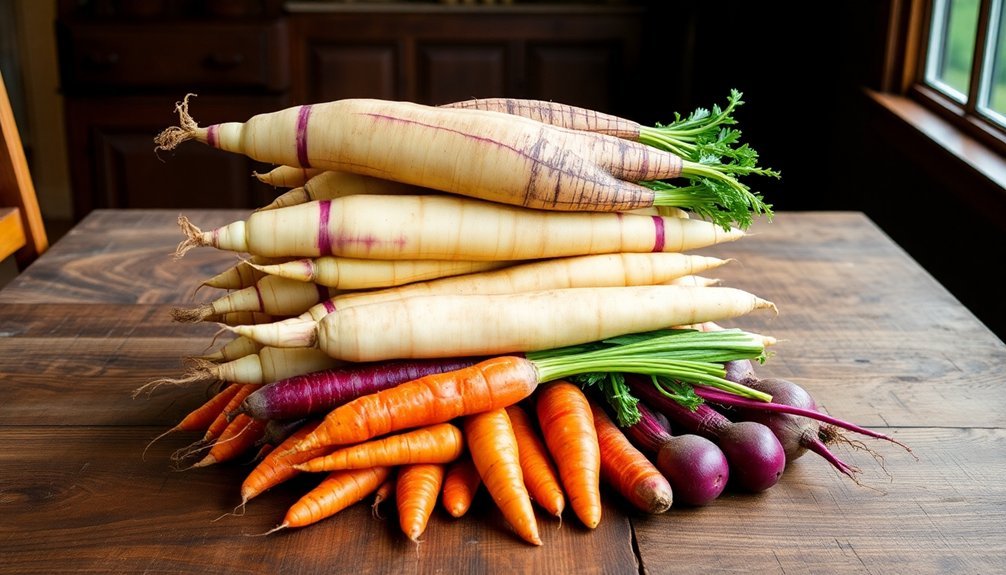
Consider your cooking plans and taste preferences when choosing varieties.
If you're planning to eat them raw, opt for younger, more tender specimens. For roasting or long-term storage, mature vegetables often work better.
Don't forget to factor in your local microclimate when selecting varieties to grow, as some root vegetables perform better in certain conditions than others. The best time to make your selection is during the autumn harvest season, when quality and variety peak due to optimal growing conditions.
Root Cellar Layout Fundamentals
A well-designed root cellar starts with proper location and structural fundamentals. You'll want to dig below the frost line, ideally into a north-facing hill slope for natural insulation. Make sure to install concrete footers and proper drainage to prevent structural damage from freezing soil. Adding a dirt floor helps maintain optimal humidity levels naturally.
Ventilation and insulation are essential for success. Install 2-inch rigid insulation sheets on the roof, covered with polyethylene and 2-4 feet of soil. You'll need a 2-inch gap between shelves and walls for air circulation, plus floor drains to manage moisture.
| Feature | Purpose | Specification |
|---|---|---|
| Depth | Frost protection | Below frost line |
| Floor | Moisture control | Higher than outside soil |
| Shelving | Air flow | 16-inch max depth |
| Ventilation | Temperature control | 2-inch wall gaps |
| Drainage | Moisture management | Floor drains to daylight |
Your storage setup should maximize efficiency while maintaining proper conditions. Keep shelves at 16 inches deep maximum, and use sand-filled boxes for additional insulation. Don't forget to organize different zones based on vegetable temperature preferences – cooler areas for root vegetables and warmer spots for squash and tomatoes.
Proper Layering Methods
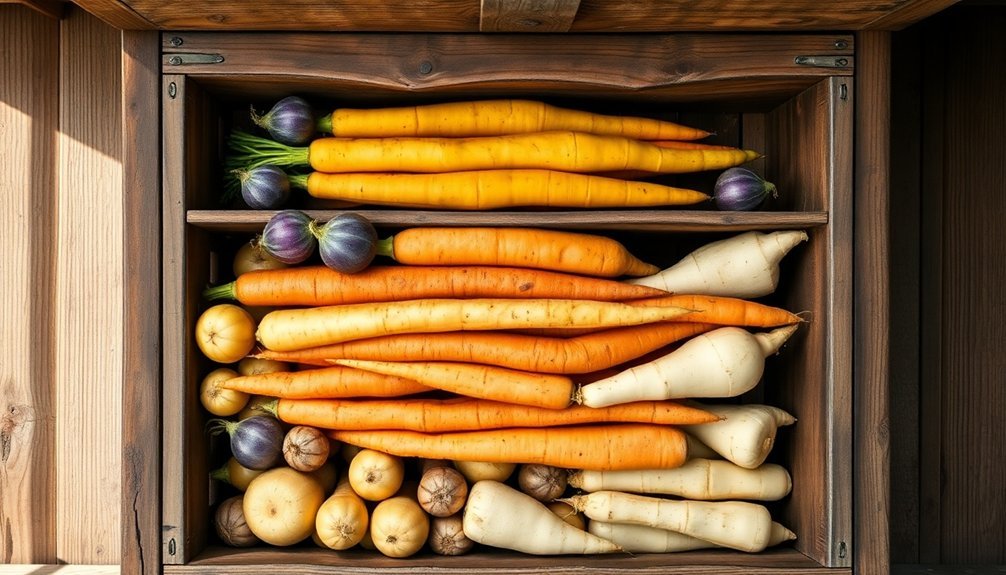
Successful root vegetable storage depends on proper layering techniques that protect your harvest from spoilage and temperature fluctuations. When you're stacking root vegetables, you'll need to create distinct layers that work together to maintain ideal storage conditions. Similar to how mound layering methods work for propagating woody plants, this technique creates optimal conditions for preservation.
Start by laying down a thick bed of straw or leaves as your foundation. Place your root vegetables on top, making sure they don't touch each other to prevent the spread of decay. Cover this layer with more straw or leaves, then repeat the process until you've stored all your vegetables.
You'll want to maintain a consistent temperature between 32-38°F throughout the stack.
For added protection, you can bed your roots in slightly moistened sphagnum moss or clean sand. If you're using containers, place them in a cool, dark location and guarantee the packing material stays slightly damp.
Don't forget to poke holes in any plastic bags you use to prevent moisture buildup.
Top off your stack with a thick insulating layer of straw or leaves, followed by soil. This final layer is essential for maintaining steady temperatures and protecting your vegetables from freezing, especially in underground storage systems.
Temperature Control Zones
The implementation of temperature control zones plays an essential role in preserving your root vegetables during storage. You'll want to maintain temperatures between 16-28°C (61-82°F) to guarantee ideal preservation and prevent premature sprouting or decay.
To create effective temperature control zones, you'll need to stack your vegetables strategically. Place heat-sensitive root vegetables in the coolest areas, typically near the bottom of your storage space where temperatures remain more stable.
If you're using a circulation system, position your storage containers so they benefit from the consistent airflow while avoiding direct contact with cooling or heating elements.
You can monitor and adjust temperatures using modern control systems that connect to your mobile device. This allows you to maintain suitable conditions even when you're away from your storage area.
Pay special attention during extreme weather conditions, as proper temperature control can reduce stress on your stored vegetables and extend their shelf life considerably.
Ventilation and Humidity Balance
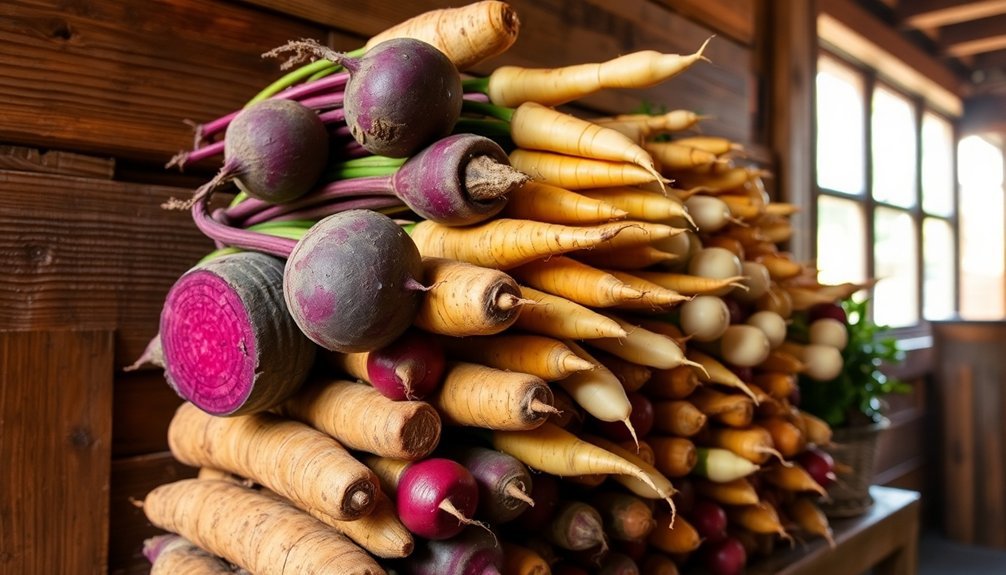
Beyond temperature control, proper ventilation and humidity work together to create ideal storage conditions for root vegetables.
You'll need to maintain humidity levels between 85-95% while guaranteeing adequate airflow to prevent decay. Set up your storage area with wooden crates or boxes that have slats or holes, and don't stack them too tightly against each other.
To balance humidity and ventilation, you'll want to use perforated plastic bags or containers that aren't completely sealed.
Install vents or fans to regulate airflow, and maintain a dirt floor if possible. You can add moisture by sprinkling the floor with water or using damp sawdust, but be careful not to create standing water or condensation.
Monitor your storage area regularly with a hygrometer, and take action if you notice any issues.
Remove spoiled vegetables immediately, and guarantee there's enough space between containers for air to circulate. You can use moisture-absorbing materials like charcoal if humidity gets too high.
Clean your storage area annually with a chlorine bleach solution to prevent mold growth, and you'll keep your root vegetables fresh for months.
Seasonal Storage Rotation
You'll want to rotate your root vegetables using a first-in, first-out system, clearly marking harvest dates on storage containers to track freshness.
Different temperature zones in your storage area affect vegetable longevity, so position newer harvests in the coolest spots while moving older produce to more accessible, slightly warmer areas for immediate use.
Label your storage zones and containers with both contents and dates, making it easier to maintain an organized rotation system that prevents waste and guarantees you're using vegetables at their peak quality.
First In, First Out
Managing root vegetable storage effectively requires a systematic approach to rotation, which is why implementing a First In, First Out (FIFO) system is essential. You'll want to organize your storage area so that older vegetables are easily accessible and used before newer harvests. Label your storage containers or areas with harvest dates and expected shelf life to maintain ideal rotation.
| Storage Zone | Harvest Date | Use-By Priority |
|---|---|---|
| Front Bins | Early Fall | Immediate Use |
| Middle Bins | Mid Fall | Medium Term |
| Back Bins | Late Fall | Long Term |
| Reserve Area | Winter | Emergency Stock |
To implement FIFO effectively, place newly harvested vegetables behind or beneath older stock. You'll need to regularly inspect your stored vegetables and move older items forward as you use them. Keep detailed records of what you've stored and when, marking containers clearly with harvest dates. This system helps you maintain quality control and reduces waste by ensuring older vegetables don't get forgotten at the back of your storage area. When you're adding new harvests, take the time to reorganize existing stock, removing any showing signs of decay to protect your entire storage inventory.
Temperature Zones Matter
Don't forget about humidity control – it's just as vital as temperature.
You can maintain 85-95% humidity by using sphagnum moss, peat moss, or breathable containers.
Layer your vegetables with straw or hay in storage bins, and protect them from direct cool winds that could dry them out.
Remember to remove any fasteners from bunched vegetables to guarantee proper air circulation throughout your storage area.
Label Everything Clearly
Proper labeling serves as the backbone of successful root vegetable storage. When you're stacking root vegetables, maintaining a clear labeling system isn't just about organization—it's about preserving your harvest effectively.
You'll want to create waterproof labels that include storage dates, required conditions, and any special handling instructions for each vegetable type.
Your storage rotation plan should align with seasonal availability and crop rotation practices. Keep detailed records of which vegetables you've stored in specific areas, ensuring you don't store related plant families in the same spot for at least three years. This practice helps prevent disease spread and optimizes storage conditions.
Consider implementing these essential labeling practices:
- Label storage containers with vegetable types, dates, and required conditions using water-resistant materials
- Categorize vegetables by plant families (Nightshade, Brassica, Allium) and store them separately
- Document your storage method specifics, including whether vegetables are stored in sand, peat moss, or wrapped in paper
Preventing Cross-Contamination Between Layers
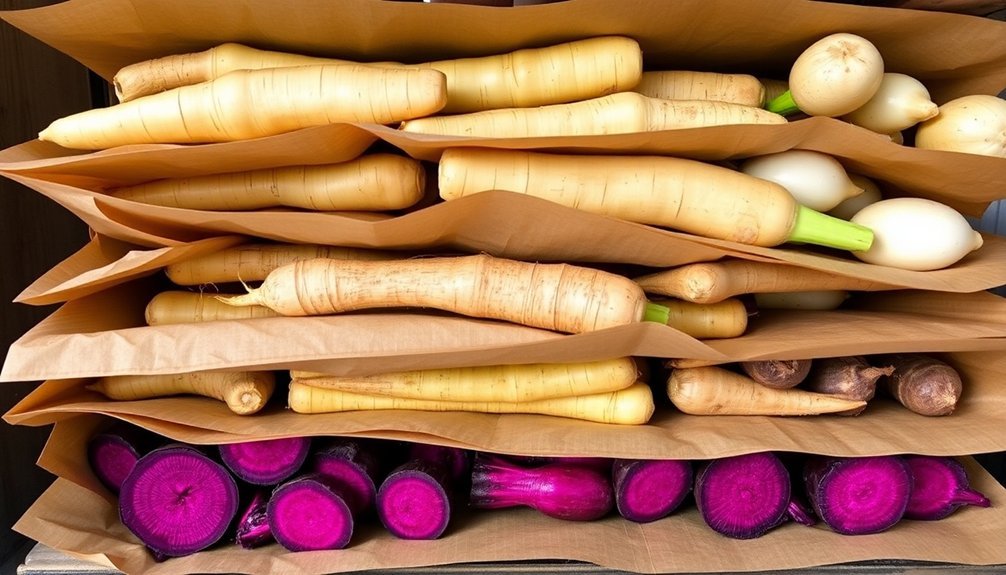
Keeping root vegetables safely stacked requires careful attention to cross-contamination prevention between layers. You'll need to separate different types of vegetables using clean, food-safe materials between each layer to prevent direct contact. This separation is vital for maintaining food safety and preventing the spread of bacteria or mold from one vegetable to another.
When you're stacking your root vegetables, use food-grade mesh or breathable materials between layers. Don't stack unwashed vegetables with clean ones, as this can lead to contamination. You should wash all root vegetables thoroughly before storage, but make sure they're completely dry before stacking to prevent moisture buildup that could lead to spoilage.
Keep your storage area at the proper temperature – around 40°F or below – to slow bacterial growth. If you notice any vegetables showing signs of decay, remove them immediately to prevent spread to other layers.
Don't mix different types of root vegetables in the same layer, as they may have different storage requirements and contamination risks. Remember to check your stacked vegetables regularly and rotate them so that older ones are used first, maintaining the first-in-first-out principle.
Frequently Asked Questions
How Long Can Stacked Root Vegetables Maintain Their Nutritional Value?
You'll find that properly stored root vegetables can maintain their nutritional value for weeks to months. When you keep them cool, dark, and humid, they'll retain essential vitamins, minerals, and antioxidants effectively.
Can Different Varieties of the Same Vegetable Be Stacked Together?
Yes, you can stack different varieties of the same vegetable together. You'll want to take into account their varying maturity times, root depths, and growth habits to guarantee successful companion planting and ideal harvest periods.
What Signs Indicate Mold Growth Between Stacked Vegetable Layers?
You'll notice white or green fuzzy spots, slimy textures, and a musty odor between layers. Watch for discoloration and soft spots. If vegetables feel soggy or have unusual colors, mold's likely growing.
Should Damaged Vegetables Be Removed Immediately From Stacked Arrangements?
You'll need to remove damaged vegetables immediately from stacked arrangements. They release ethylene gas and moisture that can spoil other produce, while their damaged areas become breeding grounds for bacteria and mold.
How Often Should Stacked Vegetables Be Checked for Sprouting?
You'll need to check your stacked vegetables twice a week for sprouting. When you spot early signs of sprouting, you should either use those vegetables immediately or remove them from the stack.
In Summary
You'll extend your root vegetables' life by months when you stack them properly in your cellar. Remember to rotate your produce seasonally, maintain proper airflow between layers, and monitor temperature zones carefully. By keeping different vegetables separated and humidity levels balanced, you're creating ideal storage conditions. With these stacking techniques mastered, you'll always have fresh, flavorful root vegetables ready for your table.

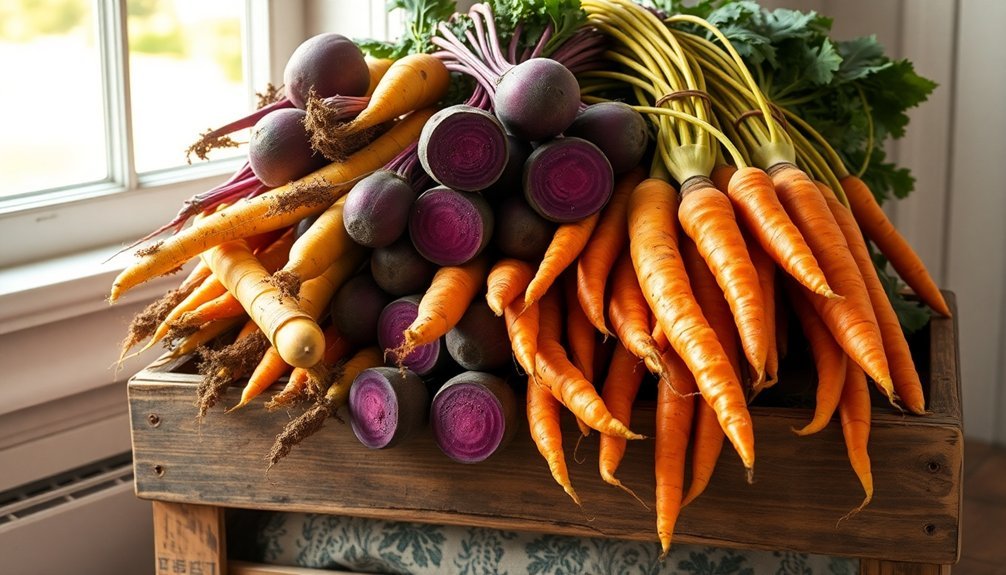



Leave a Reply